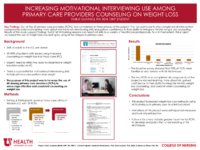The Graduate Nursing Project collection includes Doctor of Nursing Practice (DNP) Scholarly Projects and Master's students' non-thesis projects submitted as part of program requirements.
TO
- Graduate Nursing Project, Doctor of Nursing Practice, DNP, Primary Care / FNP, Poster149
- Graduate Nursing Project, Doctor of Nursing Practice, DNP, Primary Care / FNP47
- Graduate Nursing Project, Doctor of Nursing Practice, DNP, Primary Care FNP42
- Graduate Nursing Project, Doctor of Nursing Practice, DNP, Primary Care FNP, Cultural Diversity4
- Graduate Nursing Project, Doctor of Nursing Practice, DNP, Primary Care FNP, Cultural Diversity, Poster4
- More
Filters: Collection: ehsl_gradnu Type: "Text"
| Title | Creator | Date | Description | ||
|---|---|---|---|---|---|
| 51 |
 |
Improving Communication Through Discharge Education of Initial Burn Management for Patients Awaiting Outpatient Burn Clinic Follow-up | Krystle S. Ferreira; Callie Thomspon; Larrey Garett | 2024 | |
| 52 |
 |
Improving Depression and Anxiety Care in the Post-COVID Population | Larson, Alyssa I. | 2023 | Background: The coronavirus pandemic has left countless individuals with lingering symptoms, both mental and physical. Anxiety and depression were among some of the top complaints reported by patients, causing an increased need for mental health care in the post-COVID patient population. Adequate sc... |
| 53 |
 |
Improving Depression Screening and Follow-Up for Adolescents | Gay, Noemi | 2020 | AbstractBackground: Adolescent depression is a major problem in the United States. The incidence of depression in 12 to 17-year-old adolescents is estimated to be 1 in 5. The American Academy of Pediatrics recommends routine screening of depression for the 12 to 21-year-old population. The lack of u... |
| 54 |
 |
Improving Dietary Awareness Among the Parents of Elementary School Children of the Bhutanese Community in Utah (BCU) | Dulal, Biren; Reinke, Lynn | 2023 | Background: After spending an extended period in a refugee camp and experiencing food deprivation, food scarcity, and other struggles associated with a poor socioeconomic status, a refugee population is more likely to lack proper knowledge about the importance of their daily intake of vegetables, fr... |
| 55 |
 |
Improving Food Insecurity Toolkit to Improve Screening, Follow-up, and Referral Process for Food Insecure Patients at the Urban Indian Center of Salt Lake | Emily R. Royce; Danielle Puri; Jennifer Clifton | 2024 | |
| 56 |
 |
Improving Obesity Management in a Primary Care Setting | Norton, Kary M.; Lynch, Keisa | 2022 | Background: Obesity is a complex chronic condition that increases a patient's risk for many other chronic conditions. Although screening for obesity has increased in recent years, weight counseling in primary care is not ubiquitous due, in part, to providers' lack of knowledge and confidence in disc... |
| 57 |
 |
Improving Patient Self-Management of Hypertension in a Rural Primary Care Clinic | Dembergh, Katherine; Clifton, Jennifer | 2023 | Background: Hypertension (HTN) is a leading cause of cardiovascular disease and death in persons aged 35 and older. While pharmacotherapy is required for most patients, lifestyle modifications can also significantly lower blood pressure (BP). Rural populations are more likely to develop HTN, a major... |
| 58 |
 |
Improving Peripheral Venous Catheter Insertion and Maintenance in the Emergency Department Using a Quality Improvement Bundle | Jones, Alexis L.; Garcia, Kimberly | 2022 | Background: Peripheral venous catheter insertion and maintenance is a common procedure undertaken by various healthcare workers using variable techniques. Much research has been published on peripheral venous catheter insertion, maintenance, and strategies to limit complications and disparities. Des... |
| 59 |
 |
Improving Providers' Knowledge of the Benefits of Early Identification of Amyloidosis | Southwick, Haley | 2023 | Background: Transthyretin amyloidosis (ATTR) is an underdiagnosed systemic infiltrative disease that may involve the heart and cause heart failure. The median survival of cardiac amyloidosis is around 3.5 years without treatment. Earlier diagnosis is critical, as novel therapies for cardiac amyloido... |
| 60 |
 |
Improving Referral Rates of Hispanics with Type 2 Diabetes Mellitus to the IDEAS Program | Roundy, Anastasia; Garcia, Kimberly | 2022 | Background: The incidence and prevalence of type 2 diabetes mellitus (T2DM) among Hispanics in the U.S. are higher than the national average. The risk for diabetes and issues with glycemic management result from disparities in social determinants of health within the Hispanic population. Low incomes... |
| 61 |
 |
Improving Referral Rates to a Rural Hospital-At-Home Program for Oncology Patients | Mesa Meng; Marcene Littledike; Katherine Doyon | 2024 | |
| 62 |
 |
Improving Referrals to Diabetes Self-Management Education and Support Programs | McCulloch, Jessica M.; Allen, Nancy A.; Litchman, Michelle L.; Neuberger, Julie | 2022 | Background: In Utah, 8.6% of adults have diabetes, the state's leading cause of renal failure, blindness in adults <75 years old, and non-traumatic lower-extremity amputation. Diabetes self-management education and support programs improve glucose levels and prevent complications. The American Diabe... |
| 63 |
 |
Improving Screening and Provider Comfort with Counseling for Dietary Supplement Use at the University of Utah Student Health Clinic | Dolling, Rebekah A. | 2023 | Background: It is estimated that 57.6% of Americans have used at least one dietary supplement in the past 30 days. Using dietary supplements places patients at risk for adverse drug reactions. It is standard of care to assess for dietary supplement use. Implementing a toolkit to support providers in... |
| 64 |
 |
Improving Stroke Awareness in Primary Care | Twitchell, Josh | 2020 | Background: Stroke remains the second leading cause of death worldwide. Research shows that most strokes have significant modifiable risk factors. Currently primary care settings in the United States lack a systematic stroke risk screening process. It further suggests that stroke risk knowledge amon... |
| 65 |
 |
Improving the Home Blood Pressure Monitoring Program at an Urban Free Clinic | Walsh, Jeffery; Clifton, Jennifer | 2022 | Background: Many patients with abnormal blood pressures are not accurately assessed in a clinical setting. Home blood pressure monitoring allows patients to regularly check their blood pressure without having to come to a clinic. While this resource is becoming more common, it is often underutilized... |
| 66 |
 |
Improving Transitions of Care Between Inpatient and Outpatient Settings for Children and Adolescents in Foster Care: A Quality Improvement Project | Neilson, Jonathan | 2020 | Background: Transitions of care between inpatient and outpatient psychiatric settings for children and adolescents in foster care are often inadequate to ensure proper follow-up care. Gaps in communication regarding changes to medication and treatment plans have the potential to lead to patient har... |
| 67 |
 |
Increasing Advance Care Planning and Outpatient Palliative Care Referral Rates in Primary Care | Garcia, Hana M; Christensen, Scott S. | 2023 | Background: Worldwide, approximately 14% of individuals who need palliative care (PC) services are currently receiving PC and only 30% of Americans have an Advance Care Plan (ACP). Local Problem: There is a decreased awareness among policy-makers, healthcare providers, and the public about PC servic... |
| 68 |
 |
Increasing Motivational Interviewing Use Among Primary Care Providers Counseling on Weight Loss | Gunnell, Emilie | 2018 | POSTER |
| 69 |
 |
Increasing Screening and Referrals in Primary Care for Adults with Adverse Childhood Experiences | Connolly, Katie D. | 2023 | Background: Adverse Childhood Experiences (ACEs) are common and have been linked to many adverse health outcomes. Despite this evidence, only 33% of primary care providers screen for ACEs; subsequently patients are often unaware of the health impacts and less likely to be referred to psychotherapy. ... |
| 70 |
 |
Increasing Screening for Adult ADHD in Primary Care | Wynn, Taylor M.; Hart, Sara | 2023 | Background: An estimated 70% of adults with ADHD are undiagnosed, which puts individuals at increased risk of medical and psychiatric comorbidities, suicide, accidental injury, and all-cause mortality. However, primary care is ideal for screening and identifying adults at risk of undiagnosed ADHD. L... |
| 71 |
 |
Increasing Sexual Orientation and Gender Identity Data Collection in Utah Clinics | Ulsh, Alyssa A. | 2023 | Background: Sexual orientation and gender identity (SO/GI) data is largely underreported in clinics across America (Kress, et al., 2021). The absence of sexual orientation and gender identity information can contribute to the health disparities faced by the Lesbian, Gay, Bisexual, Transgender, and Q... |
| 72 |
 |
Increasing Universal Hepatitis B Virus Screening in Adults | Cheryl Anna Sherman; Keisa Lynch; Katherine Doyon | 2024 | |
| 73 |
 |
Integrating ‘APPLES' Therapy into an Early Intervention Program for Infants with Cerebral Palsy: A Needs Assessment | Erin L. Hohnholt; Sarah Winter; Allison McIntyre; Lauren Ayala; Lisa Taylor-Swanson | 2024 | |
| 74 |
 |
Maintaining Intraoperative Normothermia Using Under-Body Forced Air Warming: A Quality Improvement Project | Diamond, Sarah A.; Garrett, Larry | 2022 | Background: Intraoperative hypothermia occurs when a patient has a core temperature less than 36.1 degrees Celsius. It is a common occurrence and it occurs anywhere from 26-90% of the time patients are in the operating room. At the Huntsman Cancer Hospital, over 40% of surgical patients experience p... |
| 75 |
 |
Metformin-induced Vitamin B12 Deficiency Screening: A Quality Improvement Project | Lesley Hemphill; Diane Chapman | 2024 |
